Cornelis van Haarlem
Cornelis Corneliszoon van Haarlem (1562 – 11 November 1638) was a Dutch Golden Age painter and draughtsman, one of the leading Northern Mannerist artists in the Netherlands, and an important forerunner of Frans Hals as a portraitist.
Cornelis van Haarlem | |
|---|---|
 Self-portrait (c. 1588–1590) | |
| Born | Cornelis Cornelisz. van Haarlem 1562 |
| Died | 11 November 1638 (aged 75–76) |
| Nationality | Dutch |
| Style | Northern Mannerism |
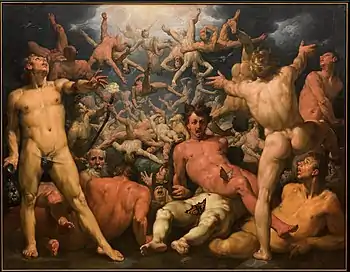
Biography
Born in Haarlem, Cornelis Corneliszoon was a pupil of Pieter Pietersz in Haarlem, and later Gillis Coignet in Antwerp.[1] He is known among art historians as a member of the Haarlem Mannerists, who were highly influenced by the work of Bartholomeus Spranger, whose drawings were brought to Haarlem by Carel van Mander in 1585, and had a strong immediate effect.[2] He painted mainly portraits as well as mythological and Biblical subjects. Initially Cornelis Cornelisz painted large-size, highly stylized works with Italianate nudes in twisted poses with a grotesque, unnatural anatomy. Later, his style changed to one based on the Netherlandish realist tradition.
When his parents fled Haarlem, as the Spanish army laid siege to the city in 1573 during the Eighty Years' War, Cornelis Cornelisz remained behind and was raised by the painter Pieter Pietersz the Elder, his first teacher. Later, in 1580-1581 Corneliszoon studied in Rouen, France, and Antwerp (with Coignet), before returning to Haarlem, where he stayed the rest of his life. He became a respected member of the community and in 1583 he received his first official commission from the city of Haarlem, a militia company portrait, the Banquet of the Haarlem Civic Guard. He later became city painter of Haarlem and received numerous official commissions. As a portrait painter, both of groups and individuals, he was an important influence on Frans Hals. He married Maritgen Arentsdr Deyman, the daughter of a mayor of Haarlem, sometime before 1603. In 1605, he inherited a third of his wealthy father-in-law's estate.
Works
Together with Carel van Mander, Hendrick Goltzius and other artists, he started an informal drawing school that has become known in art history circles as the Haarlem Academy or "Haarlem Mannerists". Probably this was a very informal grouping, perhaps meeting to draw nude models, and certainly to exchange artistic views.[2] Corneliszoon also played a role in the failed attempt to make a new charter for the Haarlem Guild of St. Luke in 1630, which tried to raise the status of the artists. His registered pupils were Salomon de Bray, Cornelis Jacobsz Delff, Cornelis Engelsz, and Gerrit Pietersz Sweelink.[1] Among his students was Cornelis Claesz Heda (brother of Willem Claeszoon Heda), who seems to have exported Cornelisz' particular brand of mannerism to India, where he was active at the court of the sultan of Bijapur.[3]
Paintings by him are on display at the Frans Hals Museum in Haarlem, the Rijksmuseum in Amsterdam, the Louvre in Paris, the National Gallery in London, the Hermitage in St. Petersburg, the Bass Museum in Miami Beach, and other museums.
Gallery
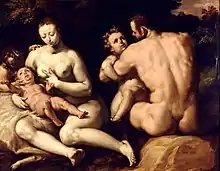 The first family (Noah and his family) (c.1582–1592)
The first family (Noah and his family) (c.1582–1592)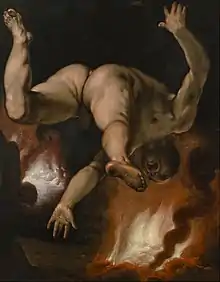 The Fall of Ixion, (1588)
The Fall of Ixion, (1588)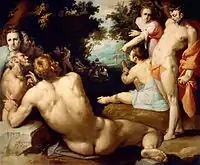 The Baptism of Christ (c.1588)
The Baptism of Christ (c.1588)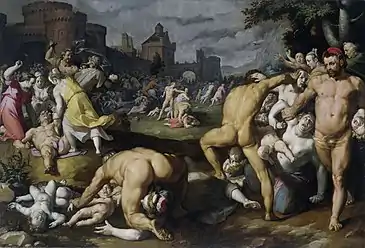 Massacre of the Innocents (1590)
Massacre of the Innocents (1590)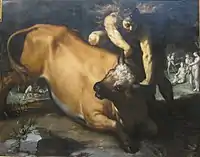 Hercules and Achelous (1590)
Hercules and Achelous (1590) The Holy Family (1590)
The Holy Family (1590) Nun and Monk (1591)
Nun and Monk (1591) Christ the Redeemer, c. 1591.
Christ the Redeemer, c. 1591. Adam and Eve (1592)
Adam and Eve (1592)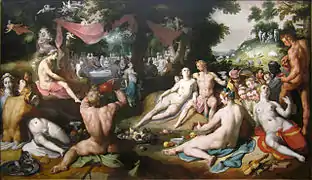 The Wedding of Peleus and Thetis, c. 1592-93
The Wedding of Peleus and Thetis, c. 1592-93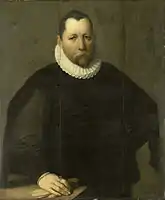 Portrait of Pieter Jansz Kies (1596)
Portrait of Pieter Jansz Kies (1596)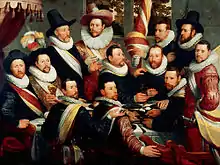 Banquet of the Officers of the Company of St. George (1599)
Banquet of the Officers of the Company of St. George (1599)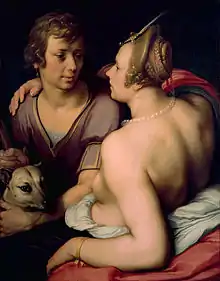 Venus and Adonis (1614)
Venus and Adonis (1614)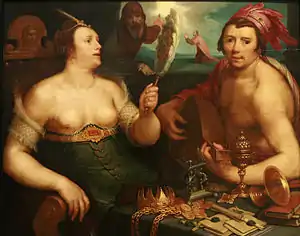 Allegory of Vanity and Repentance (1616) (oil on panel)
Allegory of Vanity and Repentance (1616) (oil on panel)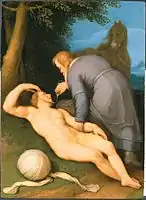 The Good Samaritan (1627) (oil on panel)
The Good Samaritan (1627) (oil on panel)
Notes
- Cornelis Cornelisz. van Haarlem in the RKD
- Slive, 8
- Gijs Kruijtzer,Xenophobia in Seventeenth-Century India (Leiden: Leiden University Press, 2009), 21
References
- Seymour Slive, Dutch Painting, 1600–1800, Yale UP, 1995. ISBN 0-300-07451-4
External links
![]() Media related to Cornelis Cornelisz. van Haarlem at Wikimedia Commons
Media related to Cornelis Cornelisz. van Haarlem at Wikimedia Commons